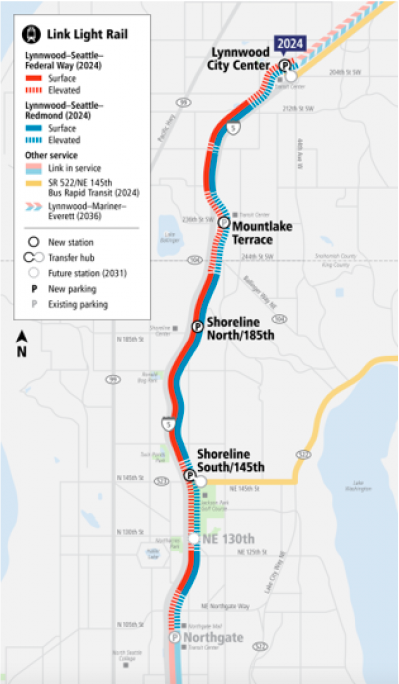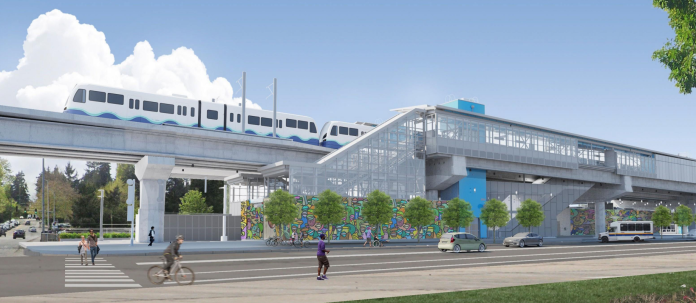
Kenmore City Councilmember David Baker offered a sharp criticism of the City of Seattle’s slow and halting process to rezone the area around 130th Street Station during Thursday’s Sound Transit System Expansion Committee meeting. Baker is one of 18 Sound Transit boardmembers who decide the fate of transit projects across the tri-county area. Transit advocates — The Urbanist included — fought to add the infill light rail station to Sound Transit plans, winning funding via the 2016 Sound Transit (ST3) vote and accelerated the timeline during the 2021 realignment process.
The argument for 130th infill station hinged on the site’s strength both to provide east-west bus connections, strengthening ties to Bitter Lake and Lake City, and to encourage transit-oriented development (TOD) in the low density residential land in the vicinity. In his remarks, Baker argued Seattle was not holding up its end of the bargain on TOD.
“If I’m not mistaken, zoning hasn’t been changed yet. It’s still pretty much residential single-family,” Baker said. “We’re talking about getting something done and built here in a couple of years and it’s not even zoned for it. So I’m really curious why the urgency on getting the project done on the Sound Transit side, but absolutely no urgency on the Seattle side.”
Seattle Mayor Bruce Harrell declined to respond to his fellow Sound Transit boardmember’s criticism. For his part, Baker said he was focused on outcomes, rather than trying to call anybody out.
“I’m sorry Mayor Harrell, I’m not trying to throw stones, but it’s just reality that they’ve had the opportunity to increase zoning in the area to make it more transit-friendly, but it’s still not done,” Baker said. “They’ve had since 2015 to fix the zoning, and it’s now 2023 and the zoning has still not been fixed. I would love to see a successful station… and the system to be as functional as it can. Everything else seems to be happening except this one.”
Sound Transit’s Ron Lewis explained that the zoning question was “outside his wheelhouse.” He added that the agency perspective that constructing the 130th infill station concurrently with the rest of the Lynnwood Link extension would avoid the service disruption that doing the work after the fact would cause. While the station will open a year or two after the rest of Lynnwood Link, that is only to allow station finishing work, not any structural work that would cause significant service disruptions.
Shifting opening dates for Lynnwood Link light rail
Lynnwood Link construction is on course to allow the extension to open in 2024 as planned; however, East Link delays are jeopardizing that plan since the extension counted on added capacity for trains at the Operation and Maintenance Facility (OMF) East in Bellevue. Without access to OMF East, Lynnwood Link would only be able to open at partial service levels, the agency says.
The Sound Transit Board has a big decision later this year whether to open an Eastside starter line until I-90 tracks can be repaired and push back the opening of Lynnwood Link. Alternatively, the agency could open the East Link all together in 2025 and open Lynnwood Link in 2024 on a reduced schedule until OMF East is tied in. Sound Transit has said it needs about six months between light rail extensions to complete the necessary testing and phase in work.
Either way, it looks like 130th Street Station will go online in 2026, shortly after the rest of Lynnwood Link opens. The station in South Shoreline at 148th Street will open earlier and serve the “neighborhood anchor” east of the station along NE 145th Street. Jason Kelly, communication director at the Seattle Office of Planning and Community Development (OPCD), said the City did accelerate planning after Sound Transit approved the earlier opening date for the 130th station.
“When the Sound Transit Board approved the new construction date of 2026, we accelerated this work,” Kelly said in an email. “OPCD has released a station area plan and zoning alternatives that can be viewed on our [130th and 145th Station Area Planning] website. Final decisions about zoning around the new station will be part of the One Seattle Comprehensive Plan update scheduled to be delivered to the City Council in 2024.”
Station area rezone
A rezone of both the 148th Street Station neighborhood anchor and the area around 130th Street Station has been in the works for many years. The City opted to attach the station rezone to the big citywide “One Seattle” Comprehensive Plan Update due in 2024. Despite all the groundwork laid, the station rezone plan is not very aggressive.
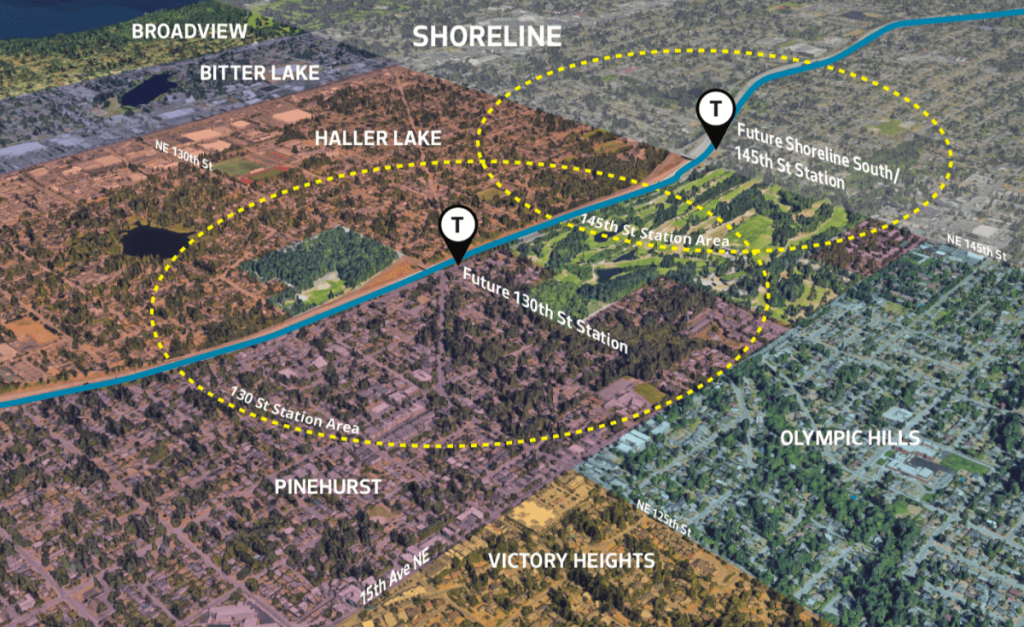
One of the main rezone options is predominantly lowrise zoning. The highest intensity option would add only 2,700 homes near both future light rail stations by 2044 according to City projections. The question of repurposing any of the City-owned land that composes Jackson Park Golf Course, which occupies a significant tract of publicly owned land near both stations, has been left hanging and unaddressed — despite some calls to use it for housing and/or more accessible and highly used park space.
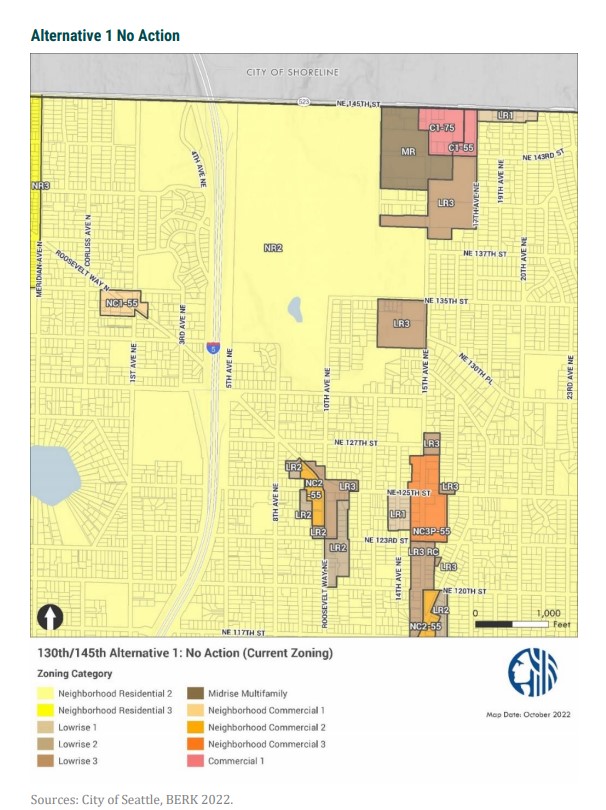
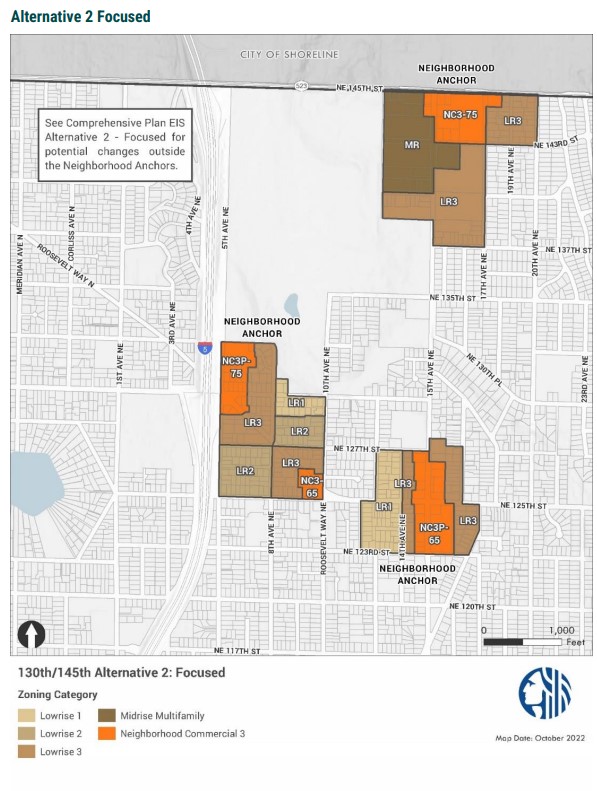
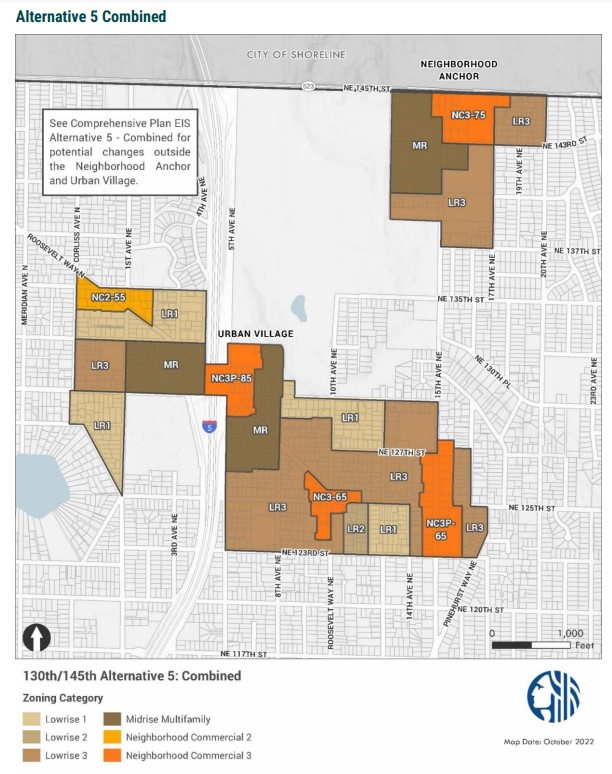
While Baker didn’t dive into the details of the zoning plan, it’s important to pass a good plan to ensure the station is a success and plenty of housing is added, not just any old plan to say we got it done.
Alternative 2 has large swathes of Lowrise 2 zoning, with a 40-foot height limit and meager 1.2 floor area ratio (FAR), even within a quarter mile of the station. “Expected building types include rowhouse and townhouse,” the City noted of Lowrise 2 in its “Description of Alternatives” document. Alternative 2 adds no zoning changes west of the station. Altogether, this anemic zoning likely would have not complied with the state TOD bill, which would have required higher density near major transit stops had it passed. The City estimates Alternative 2 would add about 2,200 homes by 2044 — note the no-change Alternative 1 is projected to add 840 homes.
Alternative 5 adds much more Midrise zoning, which has a 80-foot height limit and 4.5 FAR to support large apartment buildings, including west of the station. Beyond the Midrise zones near the station, there’s also a good deal of Lowrise 3, which can support five-story apartment buildings thanks to its 50-foot height limit and 2.2 FAR. This stretches all the way to business district on 15th Avenue NE, creating a more cohesive neighborhood rather than a set of nodes. The option would also add a strip of 55-foot Neighborhood Residential 2 on Roosevelt Way N centered around 1st Avenue NE, creating a mixed-use anchor for the western portion of the station area.
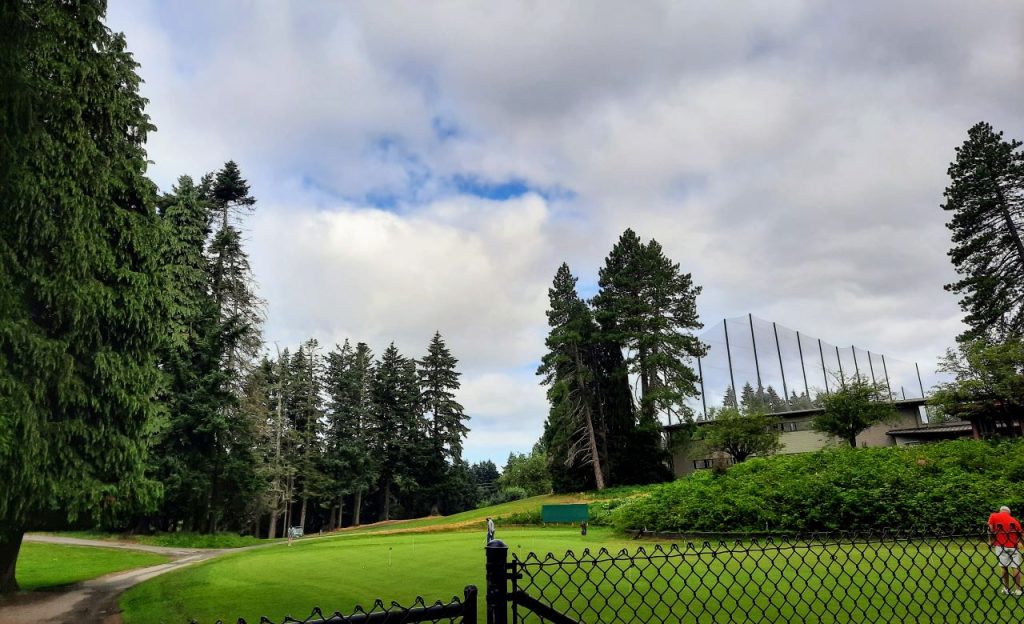
Given the much greater extent of the zoning changes in Alternative 5, it appears odd that it would add 2,703 homes — only 500 more homes than Alternative 2 over the next two decades, but that apparently is what City development modeling suggests.
The City did offer an explanation of why Alternative 3 and 4 have been omitted in its 130th and 145th station area study: “Citywide Alternative 3 – Broad and Alternative 4 – Corridors include citywide changes for the neighborhood residential areas. These changes would be the same in the station area as for other parts of the city. Alternatives 3 and 4 will be discussed generally in the citywide EIS [Environmental Impact Statement], but not specifically for the 130th and 145th station area.”
For those hoping to grow an urban neighborhood around the new station, Alternative 5 is the best of the alternatives that the City has produced thus far, but even then, some may not see it as enough. For Seattle to lead the region in adding housing near light rail investments, Alternative 5 seems the bare minimum.
This article has been updated with the quote from Jason Kelly.
Doug Trumm is publisher of The Urbanist. An Urbanist writer since 2015, he dreams of pedestrian streets, bus lanes, and a mass-timber building spree to end our housing crisis. He graduated from the Evans School of Public Policy and Governance at the University of Washington in 2019. He lives in Seattle's Fremont neighborhood and loves to explore the city by foot and by bike.

